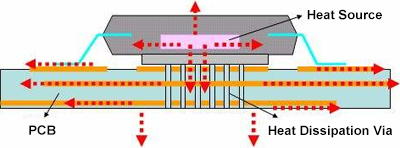For electronic equipment, a certain amount of heat is generated during operation, which causes the internal temperature of the equipment to rise rapidly. If the heat is not dissipated in time, the device will fail due to overheating and the performance of the electronic device will also decrease. Therefore, the heat dissipation of the PCB is very important.

1. Cooling through the PCB board itself
Although widely used PCB boards have good electrical properties and processing properties, they have poor heat dissipation. As a heat dissipation path for a high-heat-generating component, it is hardly expected to conduct heat from the resin of the PCB itself, but to dissipate heat from the surface of the component to the surrounding air. However, as electronic products have entered the era of miniaturization of components, high-density mounting, and high-heating assembly, it is certainly not enough to dissipate heat only by components with a very small surface area. At the same time, due to the large-scale use of surface mount components such as QFP and BGA, the heat generated by the components is transferred to the PCB in a large amount. Therefore, the best way to solve the heat dissipation is to improve the heat dissipation capability of the PCB itself and dissipate it through the PCB.
2. When there are a few devices in the PCB that generate a large amount of heat, a heat sink or heat pipe can be installed to the heat generating device. When the temperature cannot be lowered, a fan-mounted heat sink can be used to enhance the heat dissipation.
3. For devices employing free convection air cooling, it is preferred to arrange the integrated circuits (or other devices) in a vertically long manner or in a horizontally long manner.
4. Use a reasonable wiring design to achieve heat dissipation
Since the resin in the board material has poor thermal conductivity, and the copper foil line and the hole are good conductors of heat, increasing the copper foil residual ratio and increasing the heat conducting hole are the main means of heat dissipation.
5. Devices on the same printed board should be arranged as far as possible according to their heat generation and heat dissipation. A device having low amount of heat or poor heat resistance is placed on top of the cooling airflow; a device having high heat or good heat resistance is placed at the bottom of the cooling airflow.
6. In the horizontal direction, the high power device is placed as close as possible to the edge of the PCB to shorten the heat transfer path; In the vertical direction, high-power devices are placed as close as possible to the top of the board to reduce the effects of these devices on the temperature of other devices.
7. The heat dissipation of the PCB in the device mainly depends on the air flow, so the air flow path should be studied during the design, and the device or the PCB should be properly configured. When the air flows, it always tends to flow where the resistance is small. Therefore, when configuring the device on the printed circuit board, avoid leaving a large space in a certain area.
8. Temperature-sensitive devices are best placed in the lowest temperature area. Never place it directly above the heat-generating device. And the plurality of devices are preferably staggered in a horizontal plane.
9. Place the device with the highest power consumption and maximum heat generation near the best position for heat dissipation. Do not place a device with a higher heat on the corners and peripheral edges of the PCB unless there is a heat sink near it.
10. Avoid the concentration of hot spots on the PCB, distribute the power evenly on the PCB as much as possible, and keep the temperature performance of the PCB surface uniform and consistent. It is often difficult to achieve a strict uniform distribution during the design process, but it is necessary to avoid areas where the power density is too high, so to avoid the hot spot is too high and affect the normal operation of the entire circuit.